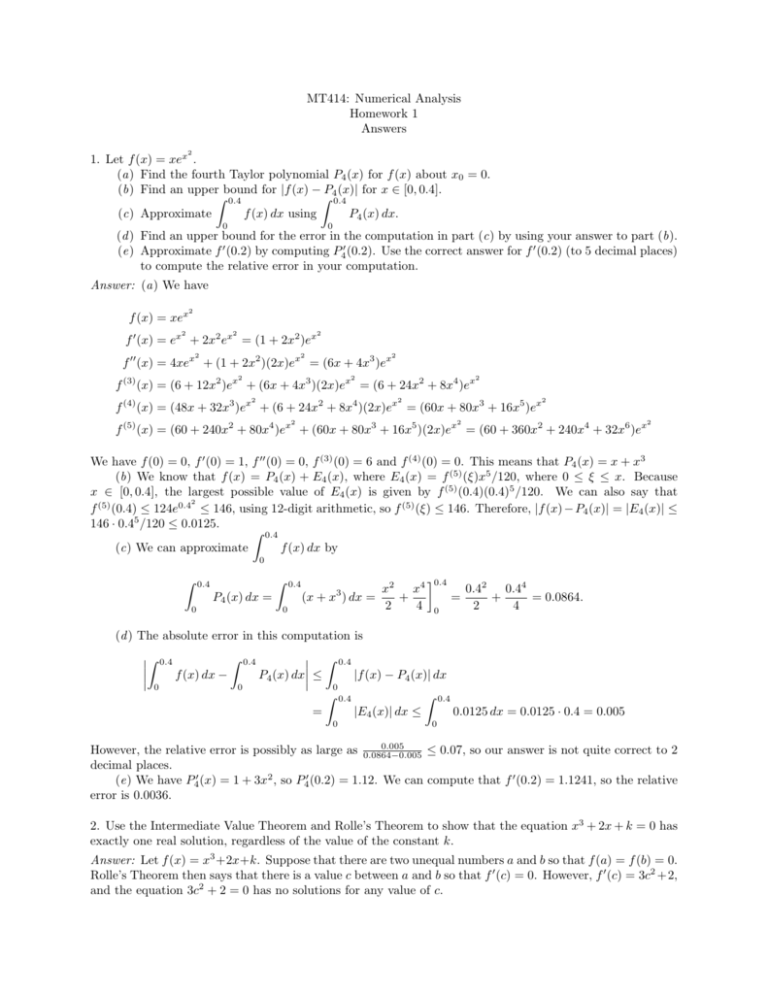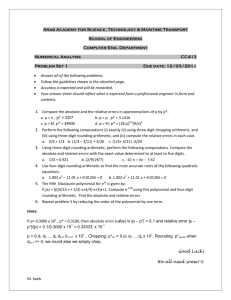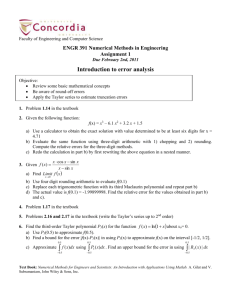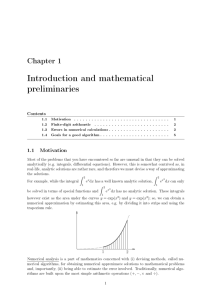MT414: Numerical Analysis Homework 1 Answers 1. Let f(x) = xe . (a
advertisement

MT414: Numerical Analysis Homework 1 Answers 2 1. Let f (x) = xex . (a) Find the fourth Taylor polynomial P4 (x) for f (x) about x0 = 0. (b) Find an upper bound for |f (x) − P4 (x)| for x ∈ [0, 0.4]. Z 0.4 Z 0.4 P4 (x) dx. f (x) dx using (c) Approximate 0 0 (d ) Find an upper bound for the error in the computation in part (c) by using your answer to part (b). (e) Approximate f 0 (0.2) by computing P40 (0.2). Use the correct answer for f 0 (0.2) (to 5 decimal places) to compute the relative error in your computation. Answer: (a) We have f (x) = xex 2 2 2 2 f 0 (x) = ex + 2x2 ex = (1 + 2x2 )ex 2 2 f 00 (x) = 4xex + (1 + 2x2 )(2x)ex = (6x + 4x3 )ex 2 2 2 f (3) (x) = (6 + 12x2 )ex + (6x + 4x3 )(2x)ex = (6 + 24x2 + 8x4 )ex 2 2 2 2 f (4) (x) = (48x + 32x3 )ex + (6 + 24x2 + 8x4 )(2x)ex = (60x + 80x3 + 16x5 )ex 2 2 f (5) (x) = (60 + 240x2 + 80x4 )ex + (60x + 80x3 + 16x5 )(2x)ex = (60 + 360x2 + 240x4 + 32x6 )ex 2 We have f (0) = 0, f 0 (0) = 1, f 00 (0) = 0, f (3) (0) = 6 and f (4) (0) = 0. This means that P4 (x) = x + x3 (b) We know that f (x) = P4 (x) + E4 (x), where E4 (x) = f (5) (ξ)x5 /120, where 0 ≤ ξ ≤ x. Because x ∈ [0, 0.4], the largest possible value of E4 (x) is given by f (5) (0.4)(0.4)5 /120. We can also say that 2 f (5) (0.4) ≤ 124e0.4 ≤ 146, using 12-digit arithmetic, so f (5) (ξ) ≤ 146. Therefore, |f (x) − P4 (x)| = |E4 (x)| ≤ 146 · 0.45 /120 ≤ 0.0125. Z 0.4 (c) We can approximate f (x) dx by 0 Z 0.4 Z P4 (x) dx = 0 0.4 (x + x3 ) dx = 0 x4 x2 + 2 4 0.4 = 0 0.42 0.44 + = 0.0864. 2 4 (d ) The absolute error in this computation is Z 0 0.4 Z f (x) dx − 0 0.4 Z P4 (x) dx ≤ 0.4 Z 0.4 |f (x) − P4 (x)| dx 0 Z |E4 (x)| dx ≤ = 0 0.4 0.0125 dx = 0.0125 · 0.4 = 0.005 0 0.005 However, the relative error is possibly as large as 0.0864−0.005 ≤ 0.07, so our answer is not quite correct to 2 decimal places. (e) We have P40 (x) = 1 + 3x2 , so P40 (0.2) = 1.12. We can compute that f 0 (0.2) = 1.1241, so the relative error is 0.0036. 2. Use the Intermediate Value Theorem and Rolle’s Theorem to show that the equation x3 + 2x + k = 0 has exactly one real solution, regardless of the value of the constant k. Answer: Let f (x) = x3 +2x+k. Suppose that there are two unequal numbers a and b so that f (a) = f (b) = 0. Rolle’s Theorem then says that there is a value c between a and b so that f 0 (c) = 0. However, f 0 (c) = 3c2 +2, and the equation 3c2 + 2 = 0 has no solutions for any value of c. Therefore, there is at most one real solution. How can we be sure that there is at least one solution? Here’s an argument that is probably much too detailed: If |k| ≤ 1, then f (2) ≥ 0 and f (−2) ≤ 0, so the Intermediate Value Theorem can be applied to deduce that there must be a solution. If |k| > 1, then f (|k|) > 0, and f (−|k|) < 0, so we again can apply the Intermediate Value Theorem. 3. Perform the following calculations (i ) exactly, (ii ) using three-digit chopping arithmetic, and (iii ) using three-digit rounding arithmetic. (iv ) Compute the relative errors in parts (ii ) and (iii ). (a) 4 1 + 5 3 (b) 4 1 · 5 3 (c) 1 3 − 3 11 + 3 20 (d) 1 3 + 3 11 − 3 20 Answer: We have a b c d 17 15 4 15 139 660 301 660 3-digit chopping 1.13 0.266 0.211 0.455 Relative error 0.003 0.0025 0.002 0.00233 3-digit rounding 1.13 0.266 0.21 0.456 Relative error 0.003 0.0025 0.0029 0.000133 Exact 4. Suppose that two points (x0 , y0 ) and (x1 , y1 ) are on a straight line with y1 6= y0 . Two formulas are available to compute the x-intercept of the line: x= x0 y1 − x1 y0 y1 − y0 and x = x0 − (x1 − x0 )y0 . y1 − y0 (a) Show that both formulas are algebraically correct. (b) Suppose that (x0 , y0 ) = (1.31, 3.24) and (x1 , y1 ) = (1.93, 4.76). Use three-digit rounding arithmetic to compute the x-intercept using both of the formulas. Which method is better and why? Answer: (a) We should be a bit careful here to avoid dividing by 0. It is potentially unsafe to write that the y − y0 y1 − y0 equation of the line is = , because potentially x0 = x1 . However, we are told that y0 6= y1 , x − x0 x1 − x0 x − x0 x1 − x0 so we can instead write the equation of the line as = . We can cross-multiply and write this y − y y1 − y0 0 x1 − x0 instead as x − x0 = y − y0 . y1 − y0 The x-intercept is the point on the line at which y = 0, so we can substitute y = 0 into this equation x1 − x0 (x1 − x0 )y0 and get x − x0 = (−y0 ) , or x = x0 − , which is the given formula. y1 − y0 y1 − y0 Now we can simplify: x = x0 − (x1 − x0 )y0 x0 (y1 − y0 ) (x1 − x0 )y0 x0 y1 − x1 y0 = − = . y1 − y0 y1 − y0 y1 − y0 y1 − y0 (b) The first formula gives the answer −0.00658, while the second formula gives the answer −0.0100. In this case, the second formula is better. The first one involved subtracting x0 y1 − x1 y0 . Because x0 y1 = 6.24 and x1 y0 = 6.25, the result of the subtraction has only one significant digit. We can check this by working to 10 significant digits. In that case, the first formula gives −0.0115789474 and the second gives −0.0115789470. Surely the answer is closer to −0.01 than to −0.00658. 5. The Taylor polynomial of degree n for f (x) = ex is n X xi i=0 i! . Use the Taylor polynomial of degree 9 and three-digit chopping arithmetic to find an approximation to e−5 using each of the following methods: 9 9 X X (−5)i (−1)i 5i (a) e−5 ≈ = . i! i! i=0 i=0 1 1 . (b) e−5 = 5 ≈ 9 e X 5i i=0 i! (c) Use your calculator to approximate e−5 to 8 places. Which formula, (a) or (b), gave the most accuracy, and why? Answer: We have i i! 5i 0 1 2 3 4 5 6 7 8 9 1 1 2 6 24 120 720 5040 40300 362000 1 5 25 125 625 3120 15600 78000 390000 1950000 5i i! 1.00 5.00 12.5 20.8 26.0 26.0 21.6 15.4 9.67 5.38 The formula in part (a) gives 1.00 − 5.00 + 12.5 − 20.8 + 26.0 − 26.0 + 21.6 − 15.4 + 9.67 − 5.38 = −1.81. This is obviously incorrect, because e−5 > 0. The formula in part (b) gives 1/(1.00 + 5.00 + 12.5 + 20.8 + 26.0 + 26.0 + 21.6 + 15.4 + 9.67 + 5.38) = 1/141 = 0.00709. To 8 places, e−5 ≈ 0.0067379470. The formula in part (b) becomes a bit better if we add the numbers in increasing order, to avoid losing precision. We have 1/(1.00 + 5.00 + 5.38 + 9.67 + 12.5 + 15.4 + 20.8 + 21.6 + 26.0 + 26.0) = 1/143 = 0.00699. The difficulty with the formula in part (a) is that it can involve subtracting nearly equal numbers, resulting in a loss of precision. 6. Suppose that f l(y) is a k-digit rounding approximation to y. Show that y − f l(y) ≤ 0.5 × 10−k+1 . y Answer: Suppose that y = 0.d1 d2 d3 . . . × 10n . If dk+1 < 5, then f l(y) = 0.d1 d2 . . . dk × 10n , and therefore y − f l(y) 0.0 . . . 0dk+1 . . . 5 × 10−k−1 = = 5 × 10−k = 0.5 × 10−k+1 . 0.d1 d2 . . . < y 0.1 If dk+1 ≥ 5, then f l(y) = (0.d1 d2 . . . dk + 10−k ) × 10n , and then y − f l(y) 0.0 . . . 0dk+1 . . . − 10−k 5 × 10−k−1 = ≤ = 0.5 × 10−k+1 . y 0.d1 d2 . . . 0.1









